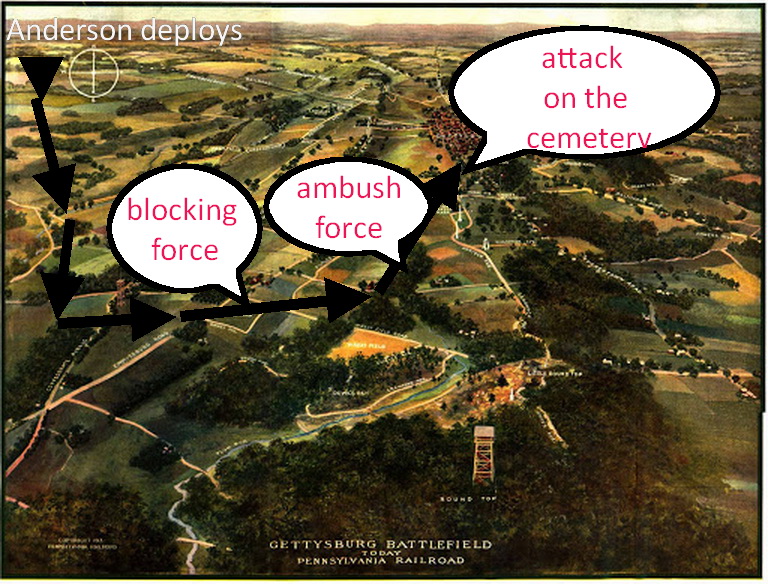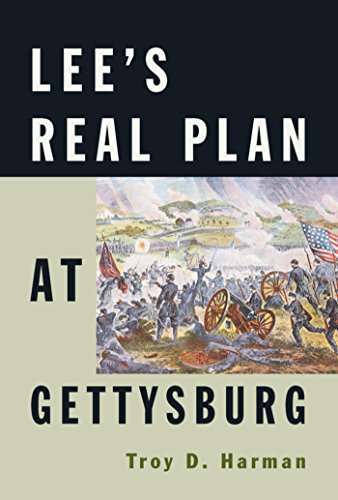The Road to Victory via one decision:
I am in continuous search for situations that might have improved the chances of the Army of Northern Virginia to prevail during their northern incursion. To date, the only way I have found for them to seize the advantage was to abandon the fight at Gettysburg and move on Westminster. But in another series of late night musings, I have developed a somewhat different scenario. It would involve Lee having access to more information than he apparently had on the morning of 1 JUL as he made his way to the battle front to view for himself what was transpiring.
We know that he seemed pleased that MG Heth’s Division had the situation well in hand and that he gave LTG Hill permission to commit MG Pender’s Division but to hold MG Anderson’s in reserve. Lee was also aware that LTG Ewell’s Corps was approaching from the north and would have been expected in the early afternoon to aid Heth.
But WHATIF he had deployed Anderson? In order for him to have done so, my musings suggest that he would have had to have had a greater understanding of that larger battle field. Apparently, this was sorely lacking! From the vantage point of the woods west of the city, he could not see the series of hills that the Union would so successfully occupy as a defensive position. Regardless, Lee would have had to have been aware or certain salient facts or likelihoods: 1) with Union cavalry present, infantry could not have been far away; 2) they would be coming from the south; 3) the nearest road and the nearest town was Emmittsburg. Sending Anderson to interdict that approach would have been a logical move.
My ALT Hx suggestion is that had he known what the terrain was like on the far side of Seminary Ridge, he might have been able to occupy that area before the Union forces. It appears from his reports that Lee viewed the battle at about 10AM, just as BG Buford was ordering his advanced line to fall back to join his main force. His cavalry would fight on alone until about noon when LTG Reynolds’ First Union Corps arrived to relieve him. LTG Howard’s Eleventh Corps arrives on the scene a few hours later.
Better overall knowledge of the battle field would seemingly have entailed two vital pieces of information: 1) the presence of McPherson’s Ridge which provided the 3300 cavalrymen with a major advantage even though they were vastly outnumbered by Heth’s division; 2) knowledge of the terrain south of the city that proved invulnerable to his attacks over the next two days. Such knowledge could have come from any of four sources had they been available or accessed by him.
The first and best source would have been reasonably accurate maps of the area. Whether just from general knowledge or prior study, Lee seemed to be aware of the relative position of the major cities in Pennsylvania. He had, after all, dispatched MG Early towards York in an effort to protect Ewell’s right flank as he approached Harrisburg. And he had sent the remainder of that Corps to the Union supply depot at Carlisle. But seemingly he had no topographical maps of the terrain features that could be important to choosing the route of advance of his army other than by following the main roadways.
The least likely source of information about the terrain would come from local residents. I say least likely in that it wasn’t likely that there were any “friendlies” in the area who would willingly disclose such vital info. This even assumes that a farmer would grasp the military relevance and importance of those hills south of the city. Another remotely possible source might have been a member of his army that knew the area; a local. But once again, he was deep into northern territory and there would have been a low possibility of finding such a soldier. His best available source of data should have been his cavalry, JEB Stuart, but he was nowhere to be found!
In short, had Lee had access to the terrain data that the Union had, he could possibly have gotten to those hills first. Tomes have been written and careers made on debating whether or not MG Early could have or should have occupied Culp’s Hill by the evening of Day 1. My ALT Hx scenario has Lee recognizing – as did every Union Commander – the value of those hills south of the town and sending Anderson’s Division around to the south of the long ridge emanating from the Seminary. First, this would allow him to set up a blocking force across the road leading up from Emmittsburg; the one Reynolds had used to reinforce the cavalry.
Anderson could have established a line in and around the knoll with the peach orchard and blocked any advance up that roadway. He could have established a look-out post on Big Round Top facing south where the panorama was not interrupted by the trees. From there they could have watched the road from Taneytown as well as the Baltimore Pike a bit farther to the east. His main body could then have moved through the saddle separating the Cemetery ridge from Little Round Top (LRT) and even up into the Cemetery; although that may have separated him too far from the brigade in the orchard.
Depending on how long it took to make that march essentially from Cashtown to LTR, he likely could have prevented the timely arrival of Hancock’s Second Corps. Another factor to consider is that Pender had a full brigade that he had not committed to assist Heth: Thomas’ Brigade. Had Anderson gotten himself into a fight, Pender might have been able to assist.
It was certainly a common practice to hold a portion of every force back in a reserve capacity to meet contingencies. We see this play out when the 6th Wisconsin Rgt was able to attack to the north at the Railroad Cut after being held to the rear of the Iron Brigade as it advanced into the Herbst Woods.
As even an alternative to this ALT HX scenario, Lee must have known that Buford’s Cavalry belonged to the First Union Corps; his command flag would have displayed that. Since the closest city was Emmittsburg, that is the most likely source of any support for Buford. By blocking the Emmittsburg Road, Lee could have “undone” Buford’s ambush plan.

The outcome of that decision:
As I reread Harmon’s excellent re-analysis of Lee’s strategy at Gettysburg, I am even more convinced that victory eluded the ANV for the lack of this one decision. Harmon points out that not only was the flank attack one of Lee’s favorite tactical moves, but that he had proven his boldness in shifting and splitting his forces to gain an advantage on the battlefield.

Traditional military command philosophy at the time was to hold back a portion of whatever forces were in play as a reserve force to be used as needed as the conflict developed. Hence, Lee gave A.P. Hill permission to commit two of his divisions (Heth and Pender), leaving Anderson in reserve. But Lee had no reason to believe that a reserve would be necessary. He thought that his infantry was facing off with only dismounted cavalry and that they should have had no problem in driving them from the field. But Lee seemingly ignored the potential threat that any Union infantry would pose to his men. Seemingly, sending Anderson south to block the Emmittsburg Road would have been a wise strategic move. Longstreet’s two divisions were following Hill’s Corps quite closely. Plus Lee knew that Ewell was en route from the north. Anderson would not have been truly isolated from support for very long. Remember, too, that Anderson’s division was one of the largest, consisting of five brigades.
I truly feel that committing Anderson is the most elegant solution to a rapid (Day 1) victory at Gettysburg. As devastating as it might have been — assuming it played out as I recount in the following sections — I do not think that it would have been sufficient to bring about the end of the war.
Meade was too new to the job to have allowed even the loss of two Corps (1st and 11th) to brought him to his knees. Lincoln, likewise, was too committed to preserving the Union to allow such a set-back to have fractured it. Those would have been only 2 of the 15 Corps that comprised the Army of the Potomac. With Lee’s entire army on Pennsylvania, any imminent threat to WASHDC would have been minimal. Replacement troops could have been fed to Meade via trains to Westminster and he could have implemented the Pipe Creek defensive line.
Lee would undoubtedly have had to pause for a few days at Gettysburg. He would have had to deal with a vast number of prisoners. He had always intended to consolidate his army there, so he’d have rested them for a few days while he aligned them for the movement to contact to the south. This would have given Meade time to establish and reinforce Pipe Creek.
